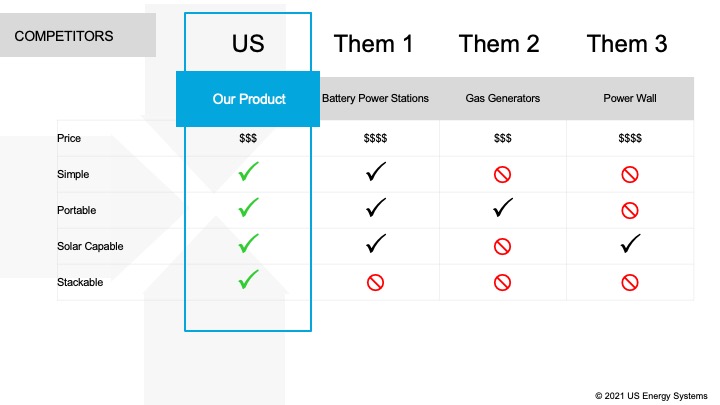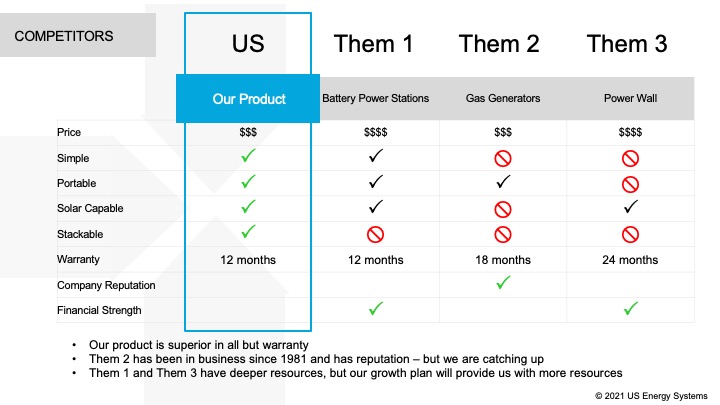We have all the checkmarks, they don’t. Why this approach fails.
The presentation gets to the Competitor section. The speaker shows a matrix comparing “Us” and “Them.” “Us” has a nice green checkmark in every row, while “Them” has a smattering of checks, but mostly “X” marks. The speaker boasts of the superiority of “Us”. The audience isn’t buying it.
It’s not that the audience doesn’t believe the speaker, in fact they do. The problem is that everyone in the room knows that if “Them” were giving the presentation, they would have all the green checks and “Us” would have all the “X” marks because “Them” would choose different criteria to compare. Not only is this approach unproductive, it’s counterproductive because the slide and the speaker missed an opportunity to shine.

The slide above is real, the names have been changed to protect the guilty. Note that “Us” is superior in every regard. Further note that the comparison is only on product features, but the investors are being asked to back the company, not just the product.
There is better way, and it starts with transparency and scope. Picture your company as “Us.”
On the transparency side, show one or more items where “Us” isn’t as good as “Them.” The speaker can explain why that is not very significant and that “Us” is working to rectify or is choosing not to compete along that dimension. Doing so will make the majority of the criteria, where “Us” does beat “Them,” much more persuasive, because the audience feels they are getting the entire, unvarnished picture.
From the scope standpoint, consider comparing not just the product, but other, non-product areas that differentiate you from your competitors. For instance, “Us” may be lacking in “Installed base of users” but have a clear advantage in “Target Awareness.” By extending the comparison beyond the product and into other dimensions, you are appealing to the investor’s desire to better understand the company and not just the product. And you are also giving yourself additional dimensions to differentiate yourself from your competitors.

Note that “Us” has a 12 month warranty, where most competitors have more. Also note that “Us” trails one or more competitors in Company Reputation and Financial Strength. Finally, note that there are three bullets along the bottom that explain each of the above three dimensions.
Presenting these three areas gives the speaker the opportunity to explain what the company is doing in each area. For instance, the speaker can say that they are testing a new manufacturing process that will increase reliability, and they are planning to offer an industry-leading 36 month warranty. Or the speaker can say that their research shows that the warranty length is not important to buyers.
On Company Reputation and on Financial Strength, the speaker can explain what the company is doing to become better in those areas.
Each of the above gives the speaker a chance to convince the audience that the company is a good bet to succeed. And by being transparent about some of the potential weaknesses, the company’s strengths become more credible and the company’s plans more believable.
There’s an analogy to a job interview. If the interviewer asks the candidate about weaknesses and the candidate says “I’m a perfectionist,” or “I have none,” it’s likely that the interviewer won’t believe the candidate and will discount some of the candidate’s strengths (not to mention adding “lack of humility” to the weakness list!). If the candidate gives a long list of severe weaknesses, that might also have a negative impact on the interviewer’s assessment. But if the candidate mentions some weaknesses but gives a credible argument to what is being done to overcome those weaknesses, then not only are those weaknesses likely to be accepted by the interviewer, but the credibility of the candidate’s strengths are bolstered by the candidate’s honesty.
The next time you make a Competitor matrix, consider the power of transparency and scope.



0 Comments